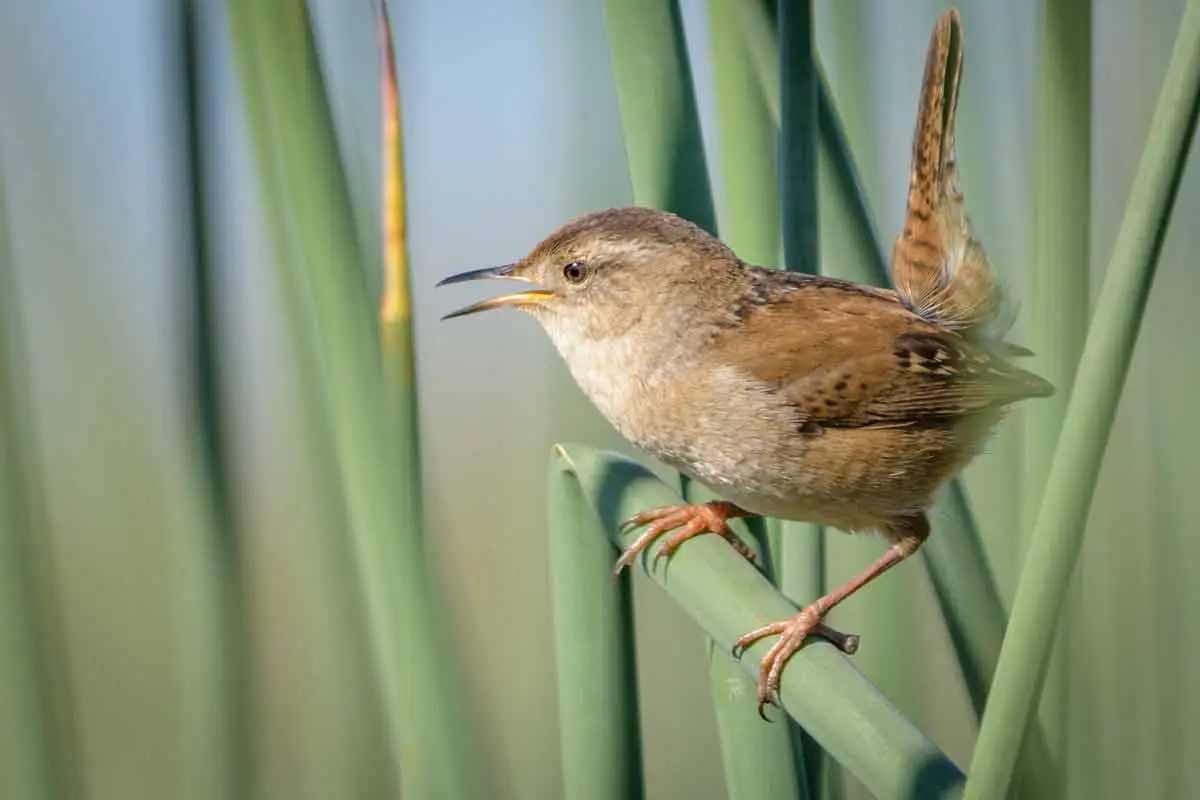North America is home to a remarkable array of wren species, with a total of 11 different types identified. Among these, Ohio has been graced with sightings of 7 wren species. Out of the Ohio wren species, 5 are considered regular residents, while 2 are accidental visitors. The purpose of this guide is to assist you in recognizing these wrens by both their appearance and their melodic calls.
Throughout the year in Ohio, you can spot Carolina Wrens. These charming creatures are present during summer, winter, and every season in between. Meanwhile, House Wrens grace the state with their presence exclusively during the summer months. When the winter arrives, Winter Wrens make their appearance, braving the chilly Ohio weather. During migration periods, Marsh Wrens and Sedge Wrens can be observed passing through the region. Lastly, keep your eyes peeled for Rock Wrens and Bewick’s Wrens, as they are known to make surprise appearances in Ohio.
Despite their unassuming appearance, wrens possess a captivating allure. These small, plump songbirds display distinctive features such as upright tails and resonant voices. Sporting a modest brown color, they blend into their surroundings effortlessly. Wrens belong to the Troglodyidae family of birds and are considered New World species, inhabiting the Americas, excluding the Eurasian Wren found in Europe and Africa.
A notable characteristic of wrens is their dietary preference for insects and spiders. This adaptable palate enables them to thrive even in harsh environments, including dry and rocky areas with minimal vegetation. It is interesting to note that Winter Wrens were previously believed to be the same species as Pacific Wrens and Eurasian Wrens. However, scientific classification now recognizes them as three distinct species.
Wrens have long been entwined in folklore, carrying symbolic meanings throughout history. In European lore, it was believed that harming wrens would invite misfortune and bad luck. This deep association with cultural narratives adds to the mystique surrounding these delightful birds.
To aid you in identifying the wren species in Ohio, this guide follows the avibase method. The list of wrens is arranged in descending order of frequency, based on observations submitted by avid birdwatchers to ebird, the state’s bird checklist repository.
For additional assistance in recognizing the various avian visitors to your backyard, consider printing a free bird identification photo guide tailored to Ohio’s diverse avifauna.
Let’s delve into the intriguing world of Ohio’s 7 wren species:
1. Carolina Wren
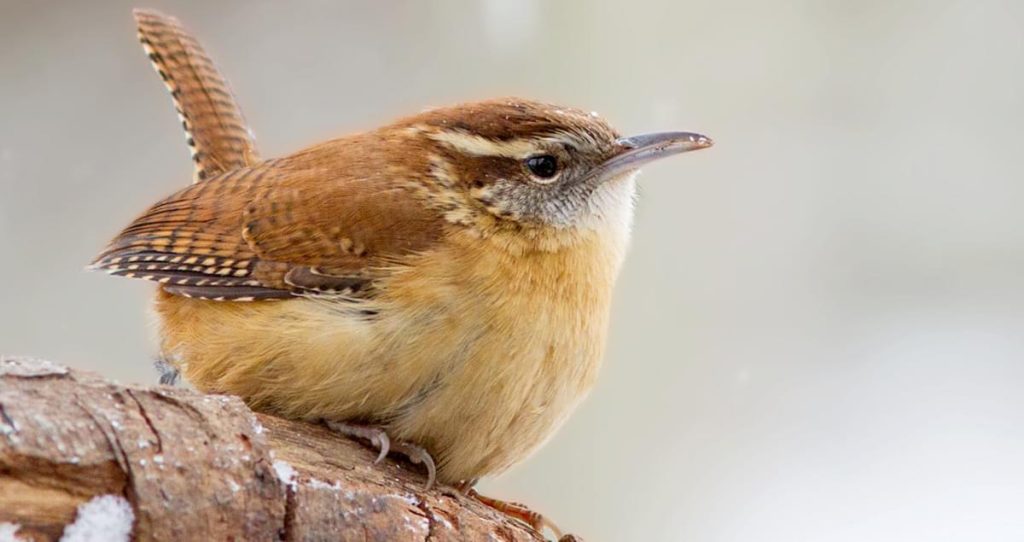
Carolina Wrens grace Ohio with their presence year-round, refusing to migrate. These delightful birds appear in approximately 20% of the birdwatchers’ summer and winter checklists for the state.
Carolina Wrens possess a shy nature and boast a dark brown upper body with a lighter brown underside. They feature a distinctive white eyebrow stripe and an upright tail.
Scientific Name: Thryothorus ludovicianus
Length: 4.7-5.5 inches (12-14 cm)
Weight: 0.6-0.8 ounces (18-22 g)
Wingspan: 11.4 inches (29 cm)
Carolina Wrens establish their year-round residency across the Eastern and Southeastern States.
Look for Carolina Wrens in woodlands and densely vegetated areas, and don’t be surprised if they pay a visit to your backyard feeders. Their diet primarily consists of insects and spiders, but they occasionally indulge in lizards, frogs, and snakes.
Carolina Wren Sounds: These birds produce short songs composed of quick whistles.
Bobby Wilcox, XC616879. Accessible at www.xeno-canto.org/616879.
Nests of Carolina Wrens are
typically located in trees, although they are not particularly selective and may construct nests in various natural or artificial sites. Their nests are often circular with a small side opening. Carolina Wrens lay 3 to 7 eggs, with an incubation period of approximately two weeks, followed by another two weeks until the chicks fledge.
To attract Carolina Wrens to your backyard feeders, consider offering suet feeders, hulled sunflower seeds, or peanut hearts in large tube or platform feeders.
Fun Fact: Carolina Wrens are known for forming lifelong pair bonds.
2. House Wren
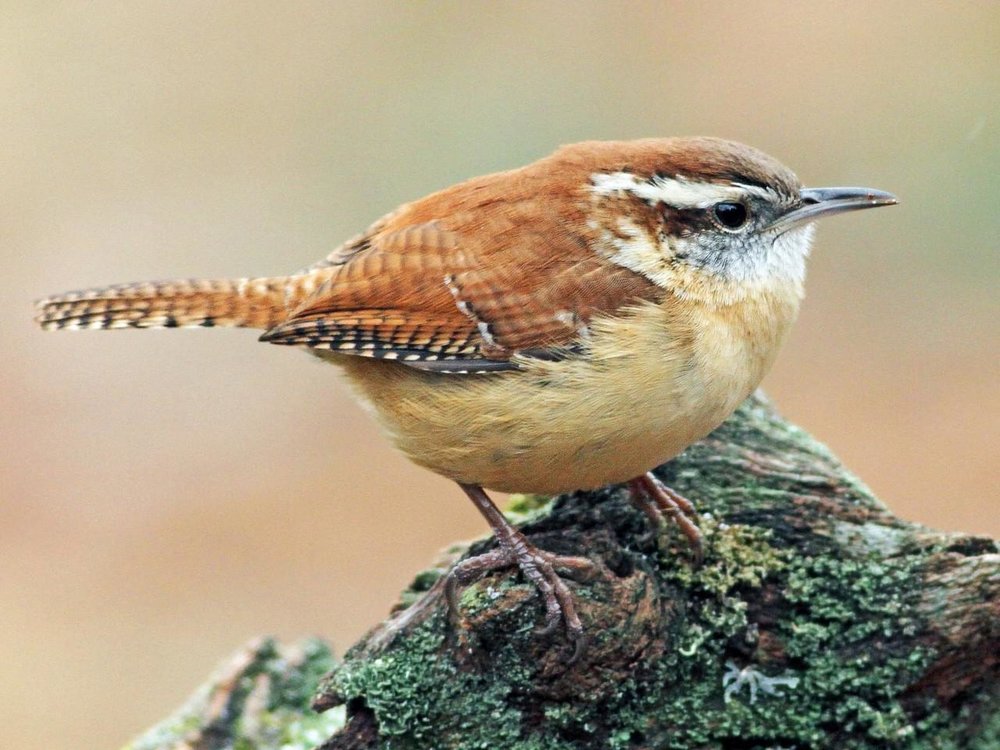
During the summer months, House Wrens dominate the wren population in Ohio, appearing in approximately 34% of birdwatchers’ checklists. These lively birds can be observed from March, with some individuals lingering until January. However, the prime months to spot them are from April to October.
House Wrens are nondescript, small, round brown birds with dark barred wings and tails, and a paler throat. Both males and females possess similar appearances.
Distinguishing Feature: The eyestripe in House Wrens is not as conspicuous as in other wren species.
Scientific Name: Troglodytes aedon
Length: 4.3-5.1 inches (11-13 cm)
Weight: 0.3-0.4 ounces (10-12 g)
Wingspan: 5.9 inches (15 cm)
House Wrens breed during the summer in the United States and Southern Canada, then embark on a migration to the South and Mexico for the winter.
You can find House Wrens in backyards, parks, and open woodlands, where they tirelessly forage for insects and spiders. These energetic birds often hop through foliage and low branches with their tails held upright, periodically pausing to emit their cheerful songs.
House Wrens primarily consume insects and spiders, including beetles, caterpillars, and flies. Additionally, they feast on snail shells to obtain calcium.
House Wren Sounds: While not known for their tunefulness, House Wrens produce a series of jumbled notes that vary in pitch and speed.
Peter Boesman, XC693927. Accessible at www.xeno-canto.org/693927.
Nests of House Wrens are typically found in old woodpecker holes, nest boxes, or other small crevices. These resourceful birds favor lightly wooded areas and construct their nests using twigs, lining them with softer materials. They lay 3 to 10 eggs, which hatch after approximately two weeks, followed by an additional two weeks until the chicks fledge.
To attract House Wrens to your backyard, consider leaving piles of brush or installing nest boxes.
Fun Fact: Despite their small size, House Wrens display remarkable tenacity when competing for the best nest holes, often engaging in confrontations with larger birds and occasionally removing eggs or nestlings from the occupied sites they desire.
3. Marsh Wren

Marsh Wrens make occasional appearances in Ohio, accounting for approximately 3% of the summer checklists. These elusive birds tend to be observed from April to October, although a few remain in the state throughout the year.
Marsh Wrens feature brown plumage with distinctive black and white streaks on their backs. Their undersides display a grayish-brown hue, and they boast the hallmark upright tail characteristic of wrens. Unlike Sedge Wrens, Marsh Wrens lack striped shoulders and possess longer bills. Males and females exhibit similar appearances.
Scientific Name: Cistothorus palustris
Length: 3.9-5.5 inches (10-14 cm)
Weight: 0.3-0.5 ounces (9-14 g)
Wingspan: 5.9 inches (15 cm)
Marsh Wrens breed in the northern United States and central Canada before embarking on migration to southern states and Mexico. Some individuals in the western regions and along the Atlantic Coast may remain in their respective areas throughout the year. These birds can be spotted during their migratory journeys across the Eastern United States.
To locate Marsh Wrens, explore wetlands where they adeptly cling to reeds, gripping each foot onto separate stalks. These elusive birds can be challenging to spot, but their songs, particularly at dawn and dusk, provide auditory clues amidst the reeds.
Marsh Wrens primarily feed on insects and spiders, plucking them from leaves in close proximity to water sources.
Marsh Wren Sounds: Marsh Wrens produce a distinctive buzzing song that can last up to 20 minutes.
Jarrod Swackhamer, XC591813. Accessible at www.xeno-canto.org/591813.
Nests of Marsh Wrens are fully enclosed, except for a small opening at the top. They are intricately woven using reeds and grasses. Marsh Wrens lay 3 to 10 eggs, which hatch after approximately two weeks, followed by another two weeks until the chicks fledge.
Fun Fact: Marsh Wrens may construct up to twenty dummy nests attached to cattails, although they typically utilize only one, destroying the eggs and nestlings of rival birds.
4. Winter Wren
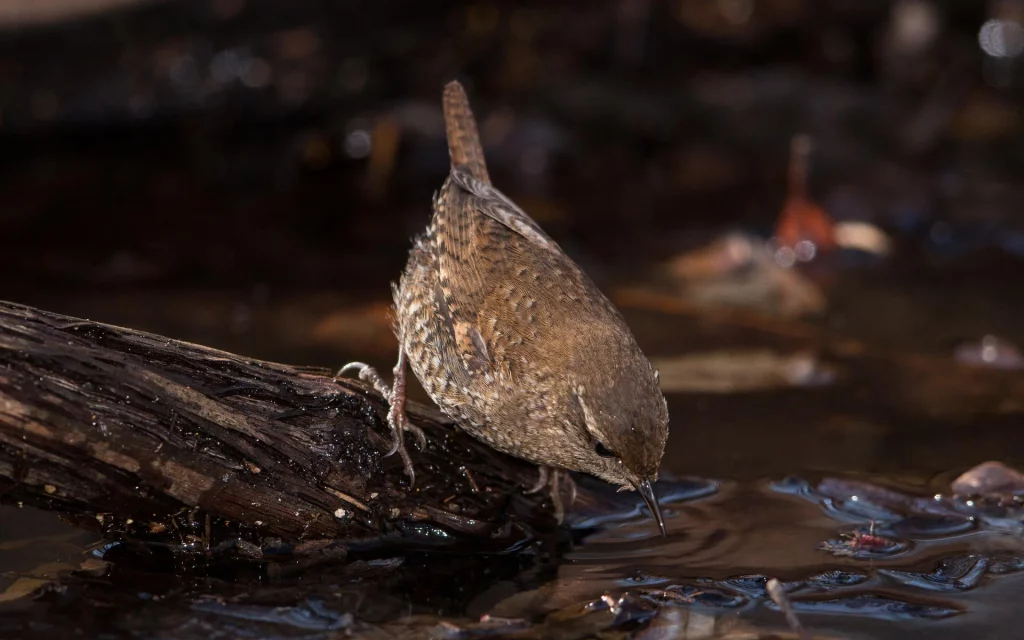
Winter Wrens are primarily observed in Ohio during the winter months, appearing in only 1% of checklists. While a few individuals may remain year-round, the period between October and January provides the best opportunity to spot them.
Winter Wrens possess small, plump bodies with brown plumage. They exhibit darker barring on their wings, tail, and belly. These wrens feature a paler eyebrow stripe and short tails that they keep upright. Both males and females share similar appearances.
Winter Wrens closely resemble Pacific Wrens and were once believed to be the same species. However, scientific classification now recognizes them as distinct, as they exhibit different songs.
Scientific Name: Troglodytes hiemalis
Length: 3.1-4.7 inches (8-12 cm)
Weight: 0.3-0.4 ounces (8-12 g)
Wingspan: 4.7-6.3 inches (12-16 cm)
Winter Wrens inhabit the eastern United States during winter, while they migrate to northeastern US states and Canada for the summer.
When searching for Winter Wrens, explore dense undergrowth in forests and backyards. They scavenge for insects and spiders by rummaging through fallen leaves and decaying bark.
Winter Wren Sounds: Winter Wrens produce a long, bubbly, and melodious song that is slower in pace than that of Pacific Wrens. Their songs can last up to 10 seconds.
David Welch, XC575300. Accessible at www.xeno-canto.org/575300.
Nests of Winter Wrens are crafted from twigs, moss, and grass intricately woven into a round shape with a small opening. They lay 1 to 9 eggs, with an incubation period of approximately two to two and a half weeks, followed by another two weeks until the chicks fledge.
To attract Winter Wrens to your backyard, cultivate native plants and preserve natural vegetation.
Fun Fact: Winter Wren nests are typically round in shape, often hanging from trees with a small opening.
5. Sedge Wren

Sedge Wrens can be spotted in Ohio from late March until early January, with peak activity during spring and fall migrations.
These small, brown wrens feature darker upperparts with streaks and barring, along with paler underparts. They possess a faint light eyebrow stripe. Both male and female Sedge Wrens display similar appearances.
Sedge Wrens bear resemblance to Marsh Wrens and occupy similar wet habitats. However, Sedge Wrens lack striped shoulders and exhibit lighter bellies compared to their Marsh Wren counterparts.
Scientific Name: Cistothorus stellaris
Length: 3.9-4.7 inches (10-12 cm)
Weight: 0.3-0.3 ounces (7-10 g)
Wingspan: 4.7-5.5 inches (12-14 cm)
Sedge Wrens breed in southern Canada, the Midwest, and occasionally further east in the United States. They migrate to spend winter in southeastern states and northern Mexico, primarily along the Gulf and Atlantic coasts.
To spot Sedge Wrens, carefully observe wet grasslands, marshy areas, and meadows abundant in vegetation. They tend to prefer shallower areas compared to Marsh Wrens, and their foraging primarily revolves around hunting for insects and spiders.
Sedge Wren Sounds: Their song consists of a few short notes followed by a series of rapid notes of a similar pitch.
Paul Driver, XC659291. Accessible at www.xeno-canto.org/659291.
Fun Fact: Sedge Wrens exhibit territorial behavior and will pierce the eggs of neighboring Sedge Wrens, eliminating potential competition.
6. Rock Wren
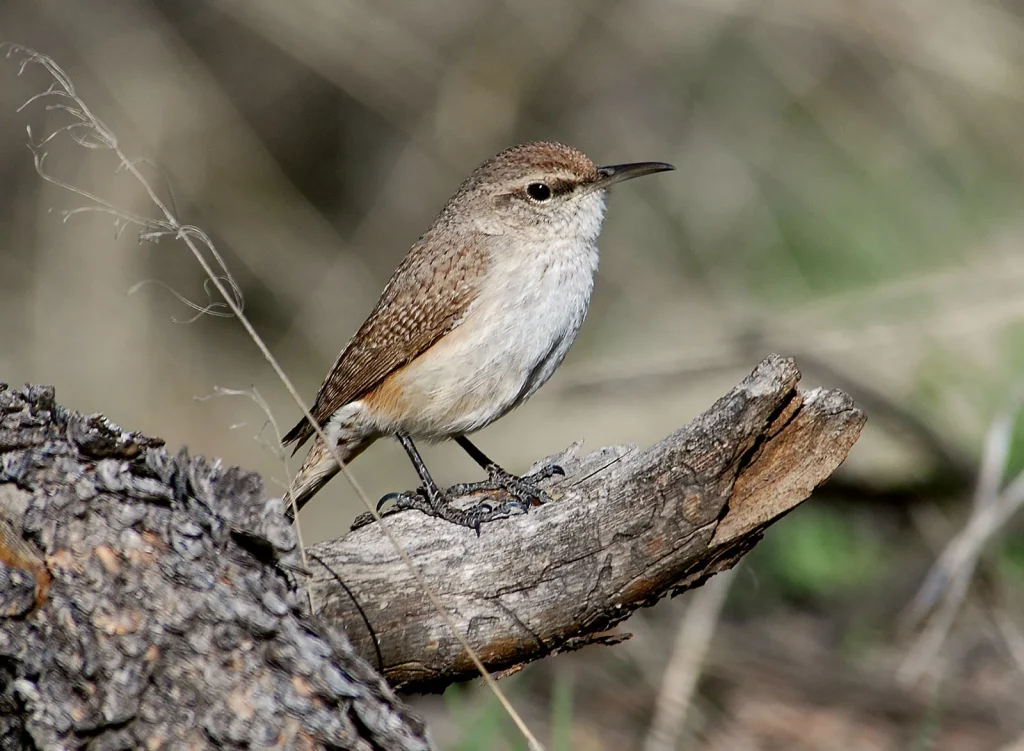
Although Rock Wrens are considered accidental visitors to Ohio, there were reported sightings near Cambridge in 2021.
Rock Wrens sport pale brown plumage on their backs, adorned with darker flecks. Their wings and tail display barring, while their underparts remain pale, with buff tones on the lower flanks and belly.
Distinctive Features: Rock Wrens possess a light eyebrow stripe, a long slightly curved bill, and dark legs. Both males and females share the same coloring. Rock Wrens often bob up and down, particularly when agitated, providing a helpful identification clue.
Scientific Name: Salpinctes obsoletus
Length: 4.9-5.9 inches (12.5-15 cm)
Weight: 0.5-0.6 ounces (15-18 g)
Wingspan: 8.7-9.4 inches (22-24 cm)
Rock Wrens inhabit dry and rocky areas in western US states and southwestern Canada. While individuals in the southern and western regions remain year-round, those in central US states migrate south for the winter.
When seeking Rock Wrens, explore dry and rocky locations with minimal vegetation. These birds thrive by feeding on insects found within crevices of rocks.
Rock Wren Sounds: Rock Wrens possess an extensive repertoire, often repeating a particular sound several times before transitioning to a different sound. Each rendition varies in pitch.
Paul Marvin, XC576852. Accessible at www.xeno-canto.org/576852.
Rock Wren nests are typically situated on the ground, often within cavities or depressions in rocky terrain. They construct nests by layering small stones followed by softer materials like wool and moss. Rock Wrens may lay up to 8 eggs, raising up to 3 broods per year.
Fun Facts: Rock Wrens construct stone walkways leading to their nests, although the purpose of this behavior remains unknown. Additionally, they acquire the necessary moisture from their insect diet, forgoing the need to drink water.
7. Bewick’s Wren

Bewick’s Wrens are exceptionally rare and accidental visitors to Ohio. The last recorded sighting in the state dates back to 1995.
These wrens showcase brown upperparts with long gray upright tails adorned with darker barring. Their bellies exhibit a gray hue, and
they boast a distinct white stripe above the eye.
Scientific Name: Thryomanes bewickii
Length: 5.1 inches (13 cm)
Weight: 0.3-0.4 ounces (8-12 g)
Bewick’s Wrens primarily reside in southern and western states throughout the year, occasionally undertaking minor movements during winter.
To spot Bewick’s Wrens, explore scrublands, thickets, and open woodlands where they nimbly hop from branch to branch, flicking their long tails. Their diet mainly consists of insects and larvae, including bees, bugs, caterpillars, and beetles.
Bewick’s Wren Sounds: Their song commences with a couple of short higher notes, followed by lower-pitched, buzzy notes.
Manuel Grosselet, XC687852. Accessible at www.xeno-canto.org/687852.
Nests of Bewick’s Wrens are typically found on rock ledges, in old woodpecker nests, nest boxes, or crevices within buildings. These cup-shaped nests are constructed using sticks and grasses, with a soft lining. Bewick’s Wrens lay 3 to 8 eggs, with an incubation period of approximately two weeks, followed by another two weeks until the chicks fledge.
To attract Bewick’s Wrens to your backyard, provide suet, mealworms, and hulled sunflower seeds.
Fun Fact: Bewick’s Wren populations in the eastern United States have declined, partly due to the encroachment of House Wrens, which may destroy the eggs of Bewick’s Wrens.
How to Attract Wrens to Your Backyard
Welcoming wrens to your backyard offers an opportunity to appreciate their melodious songs and observe their energetic behavior up close. While only a select few wren species regularly frequent backyards, including House Wrens, Carolina Wrens, and Bewick’s Wrens, you can make your outdoor space more enticing to these charming birds.
To attract wrens to your backyard, consider implementing the following ideas:
1. Embrace a Slightly Untidy Space: Provide habitats for insects and spiders, which constitute wrens’ favorite food. Leave fallen leaves, brush piles, and spider webs intact, creating a conducive environment for their prey.
2. Offer Clean Water Sources: Provide clean water, preferably in multiple locations with running water, such as birdbaths or small fountains. Wrens will appreciate having a reliable water source for drinking and bathing.
3. Nesting Opportunities: Install nest boxes suitable for wrens or leave out old boots or other nooks that may serve as potential nesting sites. Offering secure and cozy spots can encourage wrens to establish their homes in your backyard.
4. Food Availability: Wrens are known to consume mealworms and crickets, so consider providing these treats. Additionally, try offering peanut pieces and suet to diversify their diet and attract them to your feeders.
By following these suggestions, you can create a welcoming environment for wrens and increase your chances of enjoying their delightful presence in your backyard.
